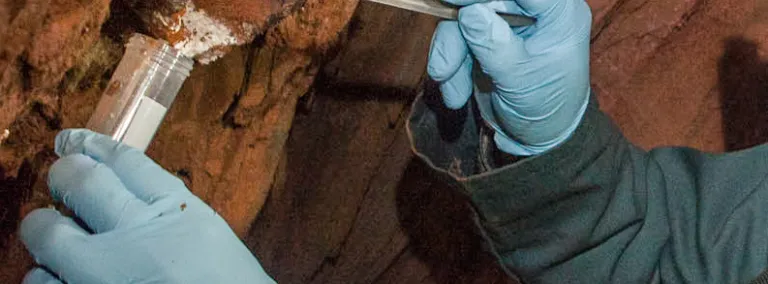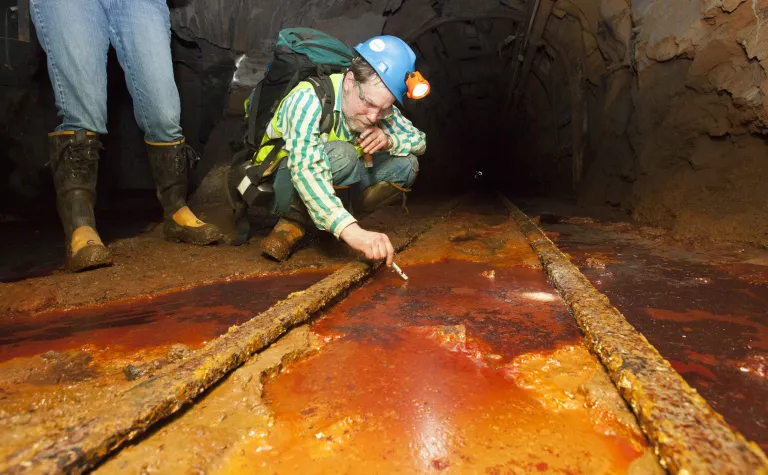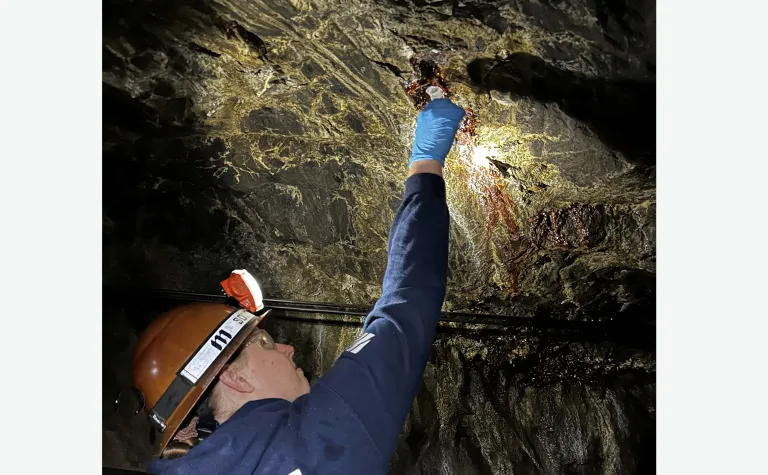University researchers discover microbes that turn CO2 gas into rocks in major advance for carbon sequestration
The microbes, discovered by researchers deep inside SURF, could help reduce carbon emissions.
At room temperature, carbon dioxide, or CO2, is a gas, which makes it hard to store for long periods of time. One idea to reduce carbon emissions involves pumping this greenhouse gas underground into deep caverns or rock layers in a process called geologic sequestration. There is major investment in this process, as noted in this Department of Energy news article: Biden administration directs $1.2B to carbon capture projects in Louisiana and Texas.
However, keeping captured CO2 underground is a challenge.
“When injected as a gas, CO2 has the potential to leak back to the atmosphere,” said Gokce K Ustunisik, Ph.D., an associate professor in the Department of Geology and Geological Engineering at South Dakota Mines. “For example, if a geologic fault occurs or when there are changes in pressure following the initial pumping on the surface, stored gas will be looking for a way to escape.”
To solve this problem, scientists are exploring efforts to bind CO2 gas underground by pumping it into rock layers with specific geochemical properties that will dissolve the gas and turn it into a carbonate mineral in a process called in-situ mineralization. However, this process takes a long time, between 7 to 10 years, in nature. But an innovation discovered by researchers working at the Sanford Underground Research Facility (SURF) could change this.
The team of researchers found a set of naturally occurring microbes inside SURF that eat carbon dioxide gas and turn it into solid rock through a process called carbon mineralization. The results come thanks to a National Science Foundation grant of $300,000 that funded the initial research.
“The first NSF EAGER grant on this project allowed us to design laboratory experiments to understand optimum conditions like pressure, temperature, time, acidity, and grain size necessary for mineralization without the help from bacteria as a first step. The conditions had never been studied before,” said Ustunisik. “Then we tested several microbes that can handle the conditions underground. Finally, we tested how fast the mineralization occurs with bacteria by running parallel experiments with and without biological activity. We found that we can store CO2 by crystallizing MgCO3-magnesite mineral in just ten days in microbe-bearing experiments.”
These microbes, or extremophiles, were found inside SURF located in the former Black Hills mining town of Lead, SD. The team has spent years hunting for these extremophiles that grow thousands of feet below ground inside water-filled rock fractures with unique properties that enable them to thrive in extreme environments.
Researchers were able to isolate four types of microbes found at SURF and show, through a series of laboratory experiments, that they can turn large quantities of carbon dioxide into rocks that will remain stable and out of atmospheric circulation for thousands of years. The team of researchers now have a patent pending on their findings.
“The discovery of life deep in the rocks 4,100 feet below the surface in SURF was thrilling,” said Tanvi Govil, Ph.D., an assistant professor in the Karen M. Swindler Department of Chemical and Biological Engineering at Mines. “We are fortunate that SURF is home to these extraordinary microbes that have survived in this extreme subsurface environment with no light, scarcity of food and limited space.”
Rajesh Sani, Ph.D., a professor in the Karen M. Swindler Department of Chemical and Biological Engineering at Mines, suggests that the discovery of these subsurface microbes that accelerate the removal of CO2 biologically was thanks to the multidisciplinary effort in this research. “Working together in a supportive and collaborative team structure involving microbiologists, geochemists, and environmental scientists with shared responsibility is the key to strengthening climate action,” said Sani.
The findings may lead to new ways to permanently capture CO2 emissions, reducing the impacts of climate change.
“This not only helps with the climate crisis, but it also has potential to spur economic development through microbially-accelerated carbon sequestration," said Bret Lingwall, Ph.D., associate professor in the Department of Civil and Environmental Engineering at Mines.
The team of researchers now have a patent pending on their findings. Detailed scientific publications on the work hinge on the patent application. The team has presented this research at multiple scientific conferences in the United States and Europe, including the Dec. 2023 meeting of the American Geophysical Union in Chicago and the July 2023, Goldschmidt Conference in Lyon, France.
Ustunisik says the next phase of research could include an attempt to use the microbes to sequester CO2 in the field. The South Dakota Mines team is seeking funding to continue this research. According to Ustunisik, the target depth for a test well is a borehole about one mile deep where the rocks can be in the range of 80-100 degrees Celsius. She says it should not be a problem to find a suitable field site to continue this research.


